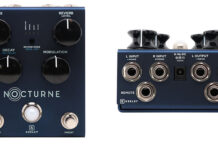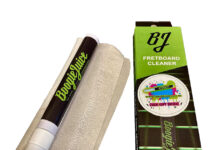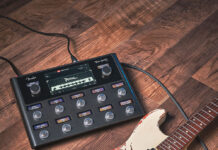
A Guide to "Symmetrical" Shredding
I remember someone telling me that George Lynch once said he heard B.B. King say something that instantly improved his guitar style.
It went something like this: “If you play a wrong note, play it again like you mean it and it’ll sound like the best note you played all night.”
The dubious origins of this gem aside, I’ve always found this to be an almost religious concept to strive toward, where any note can work anywhere if it is done with purposeful conviction.
In a guitar-player-friendly form, an easy way to play a lot of these purposefully performed “wrong” notes with conviction is through the use of licks and phrases composed of symmetrical fingerings. The trick with these is that they use the same fingering and fretting on all six strings and don’t adhere to any pure scale continuity, so you need to fit them into a fretboard context that relates to the key or chord (and its associated fingerings) you’re playing in/over.
In the case of these examples, I’ll show you how these symmetrical shapes relate to E for the convenience of performing the necessary stretches and for their ease of use over E major or E minor harmonies. But there are keys-inside-the-key that you might also notice that can be used as well. Just try to find at least two strings of the six whose fingerings sync up in some way to the key you’re playing in, and you’re ready to rock this!
Symmetrical fingerings can work with any fretting or fingering pattern (Any 1-2-3, 1-2-4, 1-3-4 pattern will work). Most almost-the-same-as-the-scale fingerings sound only OK, so I’ll be basing most of the examples on arpeggio-related shapes, since they have a wide intervallic stretch on each individual string, while having much smaller jumps when moving from string to string.
This creates a lot of interesting and unexpected melodic movement related to the fingering contour, depending on how the fingering patterns are phrased.
Based on a 1-2-4 fingering E diminished arpeggio on the E string, EXAMPLE 1A is a shape often used by Zakk Wylde, John 5 and the aforementioned George Lynch.
EXAMPLE 1B uses the shape in a ridiculously simple way to execute a pattern moving in groups of nine across successive patterns of three notes on three strings (E-A-D, A-D-G, D-G-B, G-B-E, then back the other way E-B-G, B-G-D, G-D-A, D-A-E).
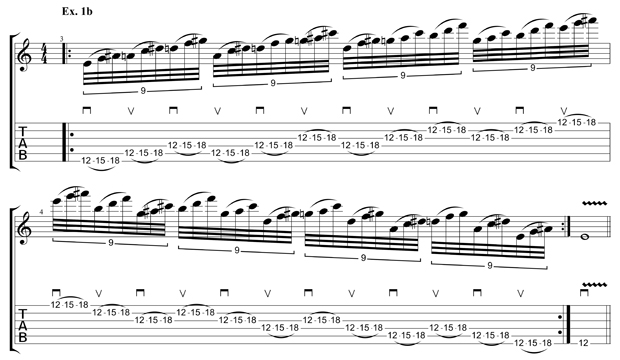
Stretch the pinky one fret further into an E minor arpeggio on the E strings (E,G,B) and you get the shape in EXAMPLE 2A, which was used to great effect by Dimebag Darrell all over the Cowboys from Hell album as well as many other examples from throughout his career.

EXAMPLE 2B uses “The Dime” in a Paul Gilbert-inspired, shred-friendly string skipping legato pattern that covers a vast intervallic range with a smooth, yet aggressive flow. Note the picking instructions and pay particular attention to the muted alternate-picked “turnaround and re-launch” in the latter half of the pattern on beat three of each bar. Be sure to try out this pattern within some of your favorite three-note-per-string scale fingerings!
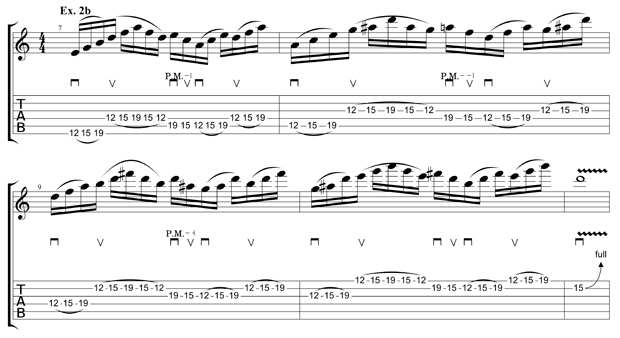
Of course, no discussion of symmetrical fingerings would be complete without mentioning Edward Van Halen, whose ever-unique guitar style has always utilized this technique with extreme sophistication, taste and conviction.
While EVH has used many different forms and variations of these fingerings throughout the years, EXAMPLE 3A depicts the E major (E, G#, B)-based shape made famous on songs like “Ice Cream Man” from Van Halen. Note the wider shift between the root note (E) and the 3rd (G#) of the arpeggio relative to the previous examples. Try both the 1-2-4 and 1-3-4 fingerings to see which allows you to most efficiently play through the shape.

On the topic of Eddie’s “Ice Cream Man” solo, EXAMPLE 3B is inspired by spirit and feel of the original lick. This is a great legato stretch exercise that utilizes the EVH-approved “hammer-on-from-nowhere” (More on that technique can be found in my previous article HERE) on the transitions from higher to lower strings and has a unique and challenging truncation of the shape at the end of each phrase that adds a very cool intervallic and melodic curve ball to the overall flow of the line.

Going to the extreme in both the physical stretch and the intervallic leaps between the notes, EXAMPLE 4A is based on an E augmented arpeggio (E, G#, C). I have affectionately named this one the “Shawn Lane” as he was known to use this shape often, and licks based around this pattern channel the spirit of the wide stretched, intervallically complex “outside” licks that flowed effortlessly from his fingers. This fingering (I highly recommend a 1-2-4) is not for the faint-of-heart, so be sure to warm up sufficiently before attempting it (Stop playing it IMMEDIATELY if you feel any sharp pain in your fingers or wrist!).

To have some fun with this shape, EXAMPLE 4B uses a Zakk Wylde-inspired picking pattern that combines both economy picking and alternate picking. Also, to continue in the Shawn Lane-vein, the patterns are grouped in 7’s, which lend horn-like flow to the lick.
To perform each pattern, start on the middle finger note on the low string with a downstroke, push through the index finger-fretted note on the adjacent string with another downstroke, and continue through the remaining notes with alternate picking (up-down-up on the 4-2-1 fingered notes on the same string, and down-up on the 2-1 fingered notes on the next higher string in the pattern). If the stretch is too much, try the pattern with any of the other symmetrical shapes depicted or with a comfortable fingering pattern of your own.

The remaining examples add in a right-hand tapping element to further expand the symmetrical shapes. EXAMPLE 5A is a shape that would be right at home in George Lynch’s style, relating to the first four notes in E Phrygian Dominant (E,F,G#,A,B,C,D) and possessing a lot of chromatic movement, overlap and half-steps.

EXAMPLE 5B begins with a “hammer-on from nowhere” that is then again used throughout the pattern, and you’ll find that in combination with the tapped notes that is makes it very easy to facilitate the string-skipped basis of the pattern. This one is very cool when you’re looking for something flashy and exotic! Be sure to finish off with a tapped artificial harmonic, fretting the 12th fret on the E and lightly tapping right above the 24th fret (or right where the 24th fret would be for those of us with 22 frets).

Finally, EXAMPLE 6A and EXAMPLE 6A continue in this Lynch-esque vein, adding a legato tap and slide into the mix and expanding the pattern even further. I’ve kept the left-hand stretch to a minimum, but you should obviously try your own variation with both the left-hand stretch pattern and the “tap-slide” spread.
In the case of these examples, the close-knit half-step relativity between the 12th and 13th frets and the 17th and 18th will create a lot of overlapping echo-type effects as you cross the pattern from string to string, especially due to the legato tap-slide-and return slide in EXAMPLE 6B. Get the pattern down, experiment and have fun!


I’ve really only begun to scratch the surface here with what is possible through the use of symmetrical fingerings. The best part with these is that since you’re not necessarily restricted to a key, there are essentially no rules, so let ‘er rip and just be sure to play, as you should always, like you MEAN IT.
Happy shredding!
Scott Marano has dedicated his life to the study of the guitar, honing his chops at the Berklee College of Music under the tutelage of Jon Finn and Joe Stump and working as an accomplished guitarist, performer, songwriter and in-demand instructor. In 2007, Scott developed the Guitar Strength program to inspire and provide accelerated education to guitarists of all ages and in all styles through state-of-the-art private guitar lessons in his home state of Rhode Island and globally via Skype. Learn more at GuitarStrength.com.
Source: www.guitarworld.com


